differential MERCEDES-BENZ GL SUV 2012 Owners Manual
[x] Cancel search | Manufacturer: MERCEDES-BENZ, Model Year: 2012, Model line: GL SUV, Model: MERCEDES-BENZ GL SUV 2012Pages: 441, PDF Size: 10.66 MB
Page 11 of 441
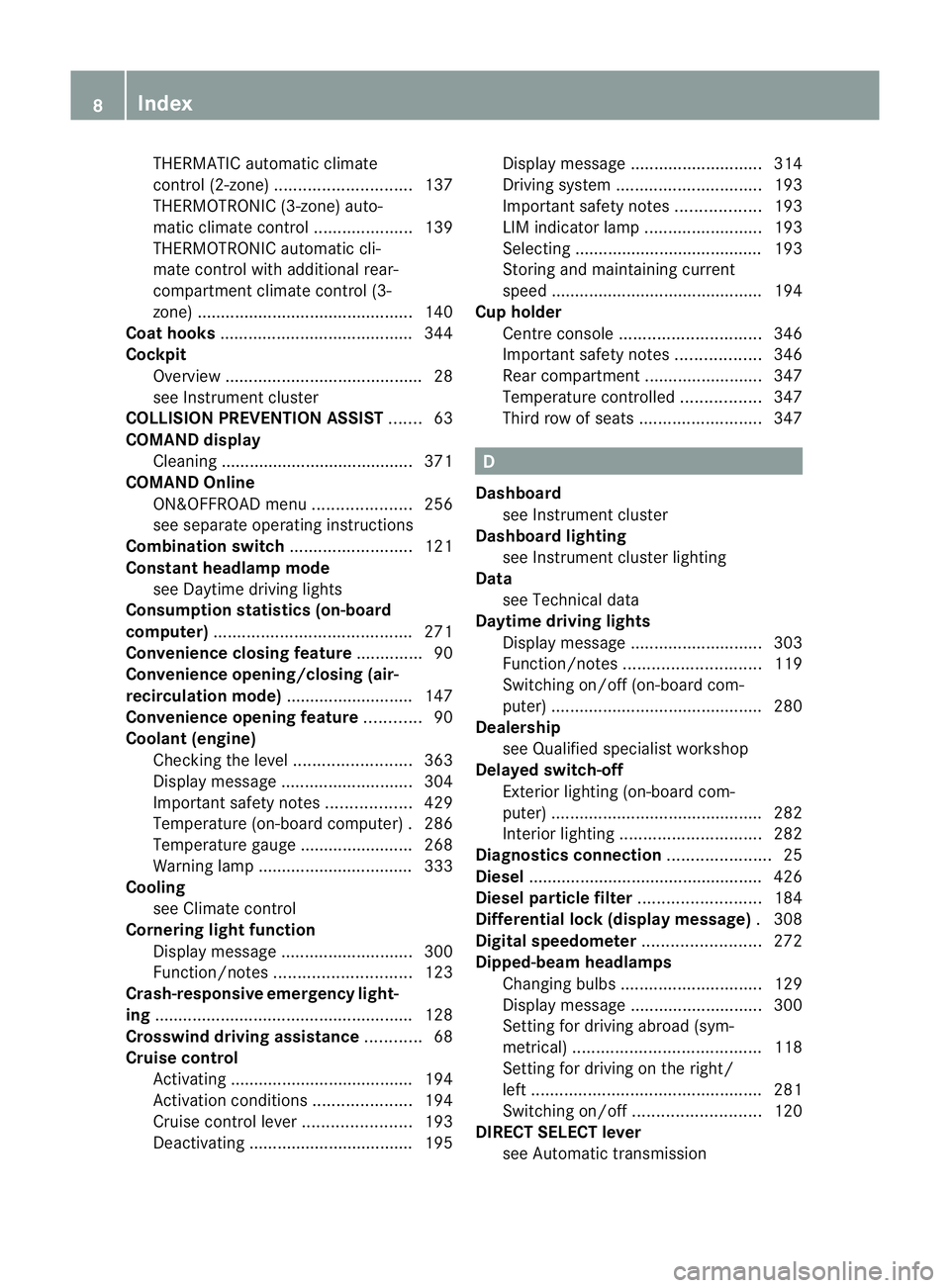
THERMATIC automatic climate
control (2-
zone) ............................. 137
THERMOTRONIC (3-zone) auto-
mati cclimate control ..................... 139
THERMOTRONIC automatic cli-
mate control with additiona lrear-
compartmen tclimate control (3-
zone) ............................................. .140
Coat hooks ......................................... 344
Cockpit Overview .......................................... 28
se eI nstrument cluster
COLLISIO NPREVENTION ASSIST .......63
COMAND display Clean ing. ........................................ 371
COMAND Online
ON&OFFROAD menu .....................256
se es eparat eoperating instructions
Combination switch ..........................121
Constant headlamp mode seeD aytime driving lights
Consumption statistic s(on-boa rd
computer) .......................................... 271
Conv enienc eclosin gfeature .............. 90
Conv enienc eopening/closing (air-
recirculation mode) ........................... 147
Conv enienc eopening feature ............90
Coolan t(engine)
Checkin gthe level ......................... 363
Display message ............................ 304
Important safety notes ..................429
Temperat ure( on-board computer) .286
Temperat ureg auge ........................ 268
Warning lamp ................................. 333
Cooling
see Climate control
Cornerin glight function
Display message ............................ 300
Function/notes ............................. 123
Crash-respon siveemergency light-
ing ...................................................... .128
Cro sswind drivin gassistance ............68
Crui secontrol
Activating ............. .......................... 194
Activatio ncondition s..................... 194
Cruis econtrol lever ....................... 193
Deactivating ................................... 195 Display message
............................ 314
Driving sy stem ............................... 193
Important safety notes ..................193
LIM ind icator lamp ......................... 193
Selecting ........................................ 193
Storing and maintaining current
spee d............................................. 194
Cu ph older
Centre console .............................. 346
Important safety notes ..................346
Rea rcompartmen t......................... 347
Temperat urec ontrolled ................. 347
Th irdr ow of seats .......................... 347 D
Dashboard seeI nstrument cluster
Dashboard lighting
see Instrument cluster lighting
Data
see Technical data
Daytime drivi nglights
Display message ............................ 303
Function/notes ............................. 119
Switch ingo n/off (on-board com-
puter) ............................................. 280
Dealer ship
see Qualified specialis tworkshop
Delayed switch-off
Exterior lighting (on-board com-
pute r)............................................. 282
Interior lighting .............................. 282
Diagn ostic sc onnec tion...................... 25
Dies el................................................. .426
Dies elparticl efilter .......................... 184
Differential loc k(display message) .308
Digital spe edometer ......................... 272
Dipped-b eamh eadlamps
Changing bulbs .............................. 129
Display message ............................ 300
Setting for driving abroa d(sym-
metrical) ........................................ 118
Setting for driving on the rig ht/
left ................................................. 281
Switch ingo n/off ........................... 120
DIRECT SE LECT lever
se eA utomatic transmission 8
Index
Page 192 of 441
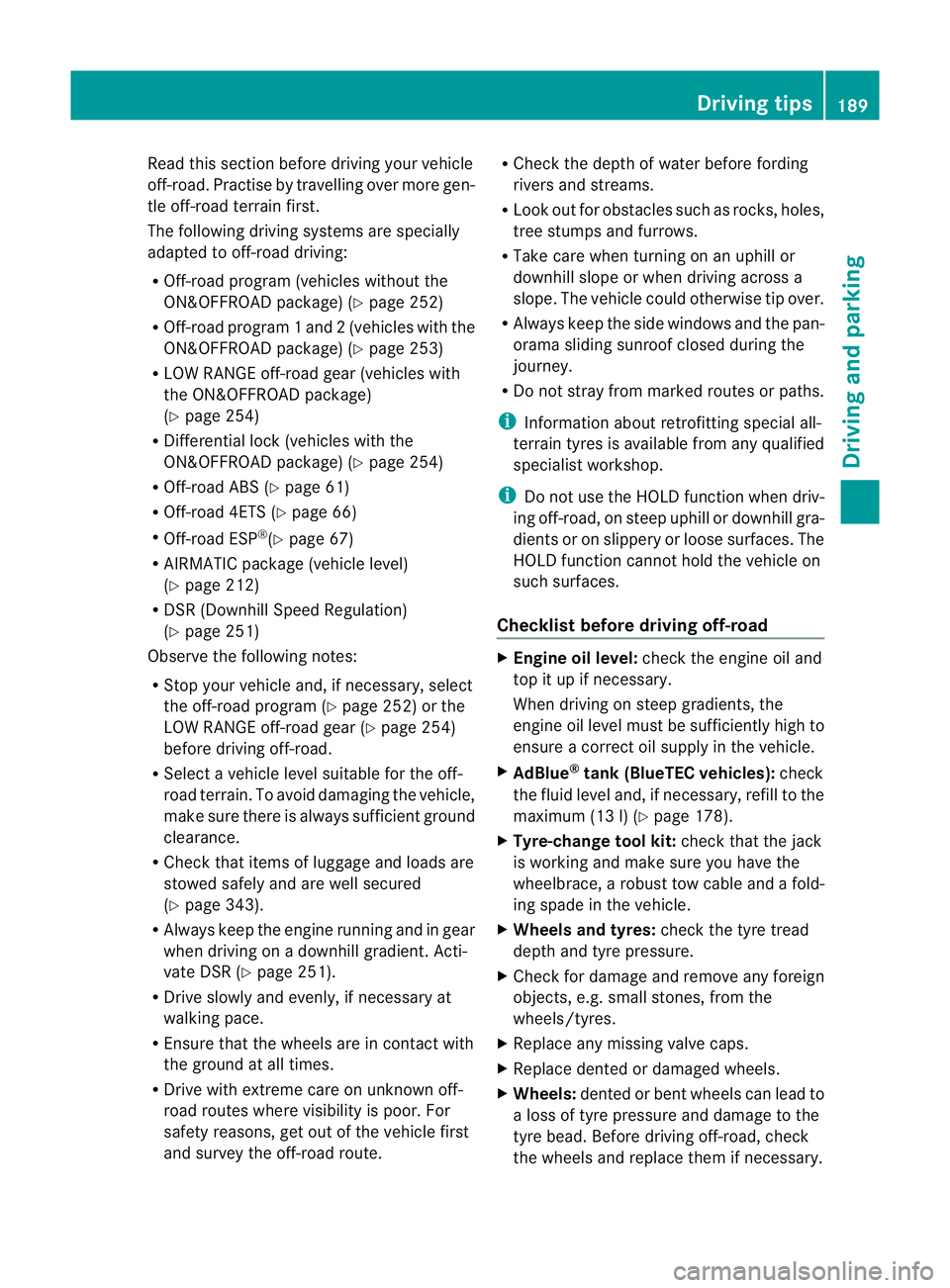
Read this section before drivin
gyour vehicle
off-road. Pra ctisebyt ravelling over more gen-
tle off-road terrain first.
The following driving systems are specially
adapted to off-road driving:
R Off-road program (vehicles without the
ON&OFFROAD package) (Y page 252)
R Off-road program 1and 2(vehicles wit hthe
ON&OFFROAD package) (Y page 253)
R LOW RANGE off-road gear (vehicles with
the ON&OFFROAD package)
(Y page 254)
R Differential lock (vehicles with the
ON&OFFROAD package) (Y page 254)
R Off-road AB S(Ypage 61)
R Off-road 4ETS (Y page 66)
R Off-road ESP ®
(Y page 67)
R AIRMATI Cpackag e(veh icle level)
(Y pag e212)
R DSR (Downh illS peed Regulation)
(Y page 251)
Observe the following notes:
R Stop your vehicle and, if necessary, select
the off-road program (Y page 252)orthe
LOW RANGE off -road gear (Y page 254)
befor edriving off-road.
R Select avehicle level suitable for the off-
road ter rain. To avoid damaging the vehicle,
make sure ther eisalways sufficien tground
cle arance.
R Check that items of luggage and loads are
stowed safel yand are wel lsecur ed
( Y page 343).
R Always keep the engine running and in gear
when driv ingonad ownhill gradient. Acti-
vate DSR (Y page 251).
R Drive slowly and evenly, if necessary at
walking pace.
R Ensure that the wheels ar einc ontact with
the ground at all times.
R Drive with extreme car eonu nknown off-
road routes where visibility is poor. For
safety reasons, get out of the vehicl efirst
and survey the off-road route. R
Check the depth of water before fording
rivers and streams.
R Look out for obstacles such as rocks, holes,
tree stumps and furrows.
R Take care when turning on an uphill or
downhill slop eorwhen driving across a
slope. The vehicle could otherwise tip over.
R Always keep the side windows and the pan-
orama sliding sunroof closed dur ingt he
journey.
R Do not stray from marked routes or paths.
i Information about retrofitting special all-
terrain tyres is available from any qualified
specialist workshop.
i Do not use the HOL Dfunction when driv-
ing off-road, on steep uphill or downhill gra-
dients or on slippery or loos esurfaces. The
HOLD function cannot hold the vehicl eon
suc hsurfaces.
Checklis tbefor edriving off-road X
Engine oil level: check theengine oil and
top it up if necessary.
Whe ndriving on stee pgradients, the
engin eoil level must be sufficiently high to
ensure acorrec toil supply in the vehicle.
X AdBlue ®
tank (BlueTEC vehicles): check
the fluid level and, if necessary, refill to the
maximum (13 l) (Y page 178).
X Tyre-ch ange tool kit: checkthat the jack
is wor king and mak esure you have the
wheelbrace, arobust tow cabl eand afold-
ing spade in the vehicle.
X Wheels and ty res: chec kthe tyr etread
depth and tyre pressure.
X Check for damage and remove any foreign
objects, e.g. small stones, fro mthe
wheels/tyres.
X Replace any missing valv ecaps.
X Replace dented or damaged wheels.
X Wheels: dented or bent wheel scan lead to
al oss of tyr epressure and damag etot he
tyr eb ead. Before driving off-road, check
the wheels and replace them if necessary. Driving tips
189Driving and parking Z
Page 253 of 441
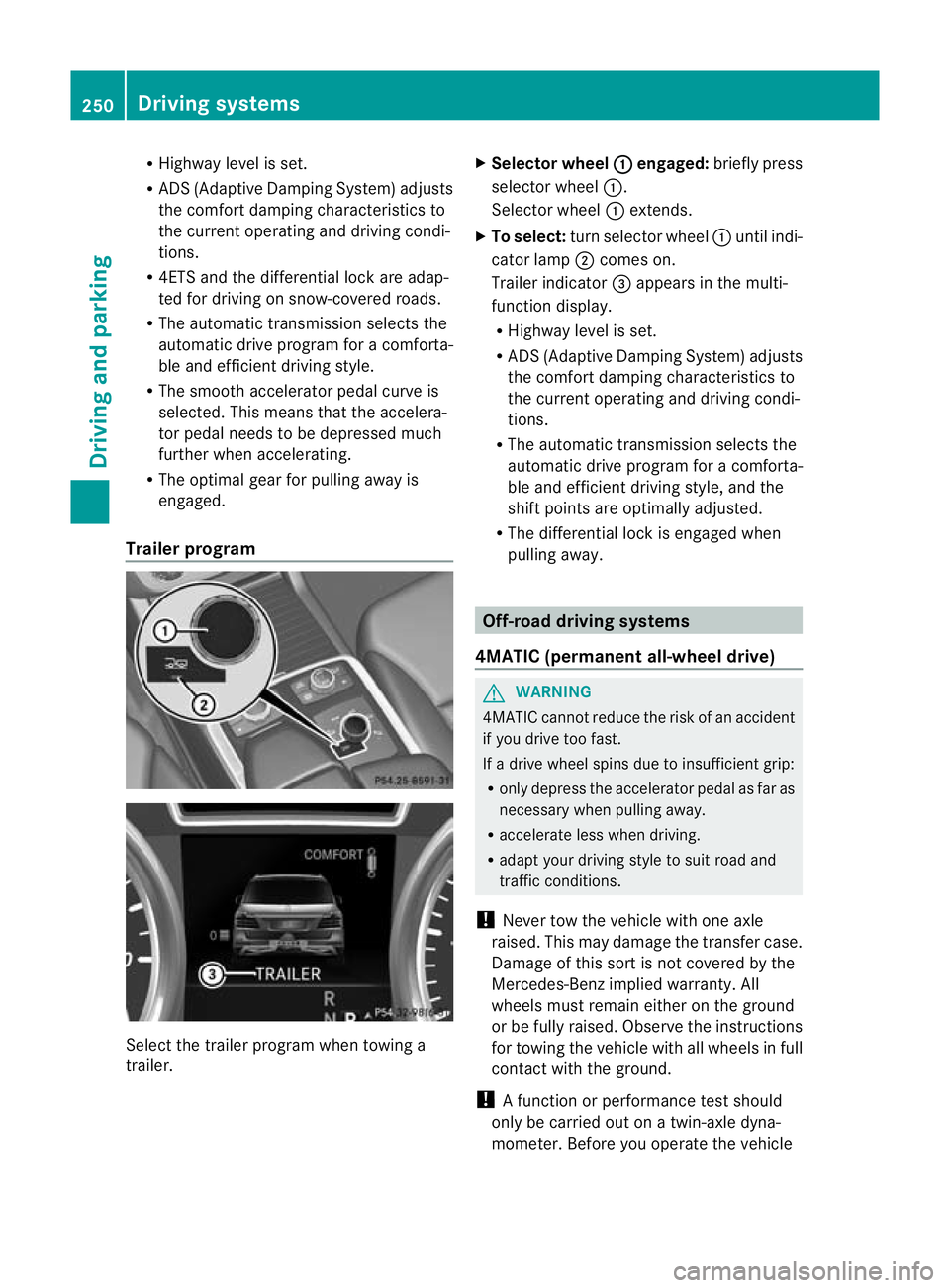
R
Hig hway level is set.
R ADS (Adaptive Damping System) adjusts
the comfort damping characteristics to
the current operating and driving condi-
tions.
R 4ETS and the differential lock are adap-
ted for driving on snow-cover edroads.
R Th ea utomatic transmi ssion selects the
automatic drive program for acomforta-
ble and efficien tdriving style.
R Th es mooth accelerato rpedal curve is
selected. This mean sthat the accelera-
tor pedal needs to be depressed much
further when accelerating.
R The optimal gear for pulling away is
engaged.
Trailer program Select the trailer program when towing a
trailer. X
Selector wheel : engaged:
brieflypress
selecto rwheel :.
Selector wheel :extends.
X To select: turnselector wheel :until indi-
cator lamp ;comes on.
Trailer indicator =appear sint he multi-
func tion display.
R Highwa ylevel is set.
R AD S(Adaptive Damp ingS ystem) adjusts
the comfort damping characteristics to
the current operating and driving condi-
tions.
R The automatic transmission selects the
automatic drive progra mforac omforta-
ble and efficien tdriving style ,and the
shift points are optimally adjusted.
R The differential lock is engaged when
pulling away. Off-road driving systems
4MATIC (permanent all-wheel drive) G
WARNING
4MATIC cannot reduce the risk of an accident
if you drive too fast.
If ad rive whee lspins due to insufficien tgrip:
R onl ydepress the accelerator peda lasfar as
necessary when pulling away.
R accelerate less when driving.
R adapt you rdriving style to su itroa dand
traffic conditions.
! Never tow the vehicle with one axle
raised. Thi smay damage the transfer case.
Damage of this sort is not covered by the
Mercedes-Benz implied warranty. All
wheels must remain either on the ground
or be fully raised. Observe the instructions
for towing the vehicle with all wheels in full
contact with the ground.
! Afunction or performanc etest should
only be carried out on atwin-axle dyna-
mometer .Before you operate th evehicle 250
Driving systemsDriving and parking
Page 257 of 441
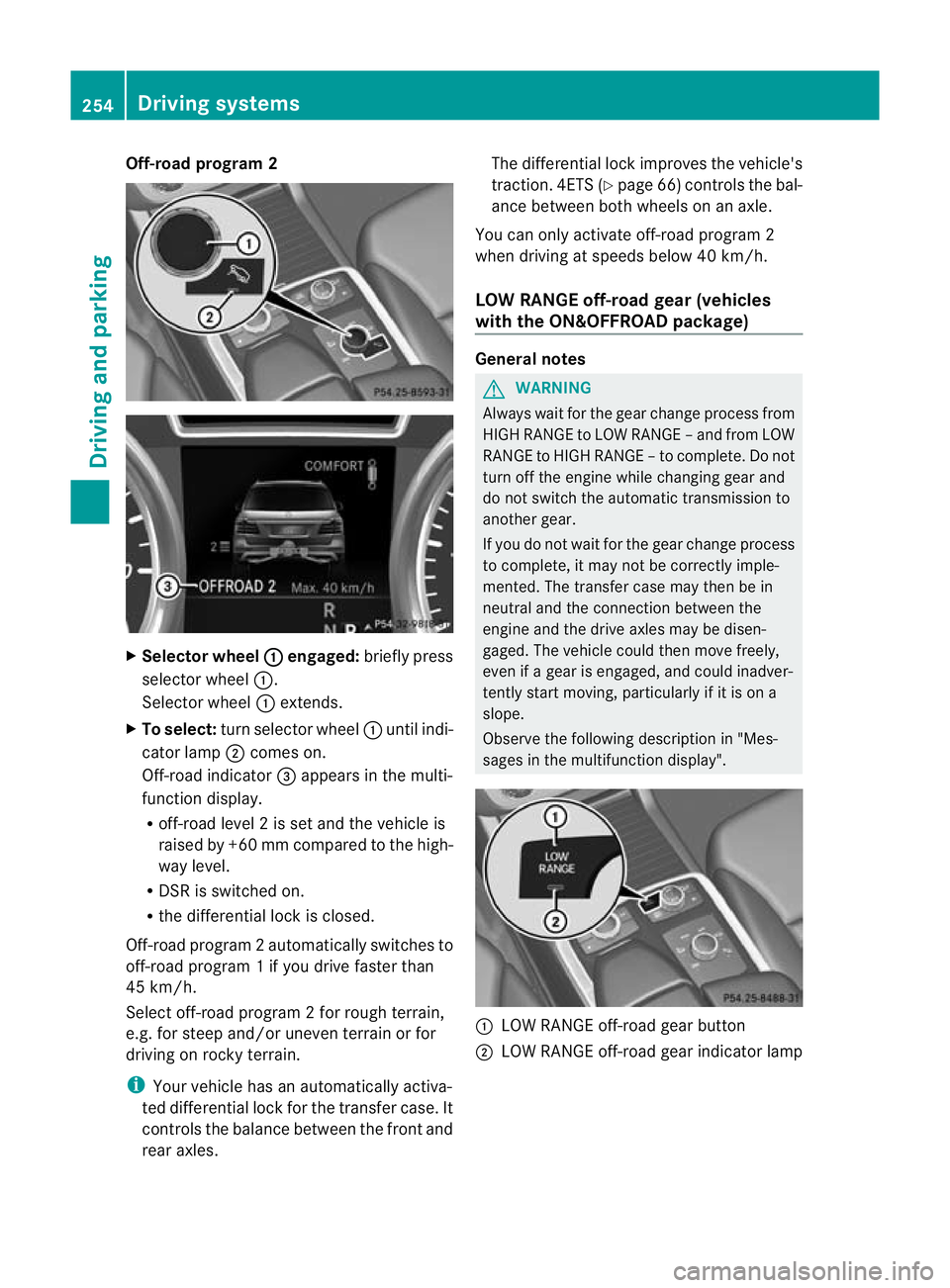
Off-road progra
m2 X
Selector wheel : engaged:
brieflypress
selector wheel :.
Selector wheel :extends.
X To select: turn selector wheel :unti lindi-
cator lamp ;comes on.
Off-road indicator =appears in the multi-
function display.
R off-road level 2isset and the vehicle is
raised by +6 0mmcompared to the high-
way level.
R DSR is switched on.
R the differential lock is closed.
Off-road program 2automatically switches to
off-road program 1ifyou dri vefaster than
45 km/h.
Select off-roa dprogram 2for rou gh terrain,
e.g. for steep and/o runeven terrain or for
driving on rocky terrain.
i Your vehicl ehas an automatically activa-
te dd ifferential loc kfor the transfer case. It
con trols the balance between the front and
rea raxles. The differential lock improves the vehicle's
traction. 4ETS (Y
page66) controls the bal-
ance between both wheels on an axle.
Yo uc an only activate off-road program 2
when driving at speeds below 40 km/h.
LOW RANGE off- roadgear (vehicles
with the ON&OFFROAD package) General notes
G
WARNING
Always wait for the gear change process from
HIGH RANGE to LOW RANGE –and from LOW
RANGE to HIGH RANGE –tocomplete. Do not
tur no ff the engine while changing gear and
do not switch the automati ctrans mission to
another gear.
If you do not wait for the gear change process
to complete, it ma ynot be correctly imple-
men ted. The transfer case may then be in
neutral and the connection between the
engine and the driv eaxles may be disen-
gaged. The vehicl ecould then mov efreely,
eve nifa gear is engaged, and coul dinadver-
tently start moving, particularly if it is on a
slope.
Observe the following descriptio nin"Mes-
sages in the multifunc tion display". :
LOW RANGE off -road gear button
; LOW RANGE off-road gear indicator lamp 254
Driving systemsDriving and parking
Page 260 of 441
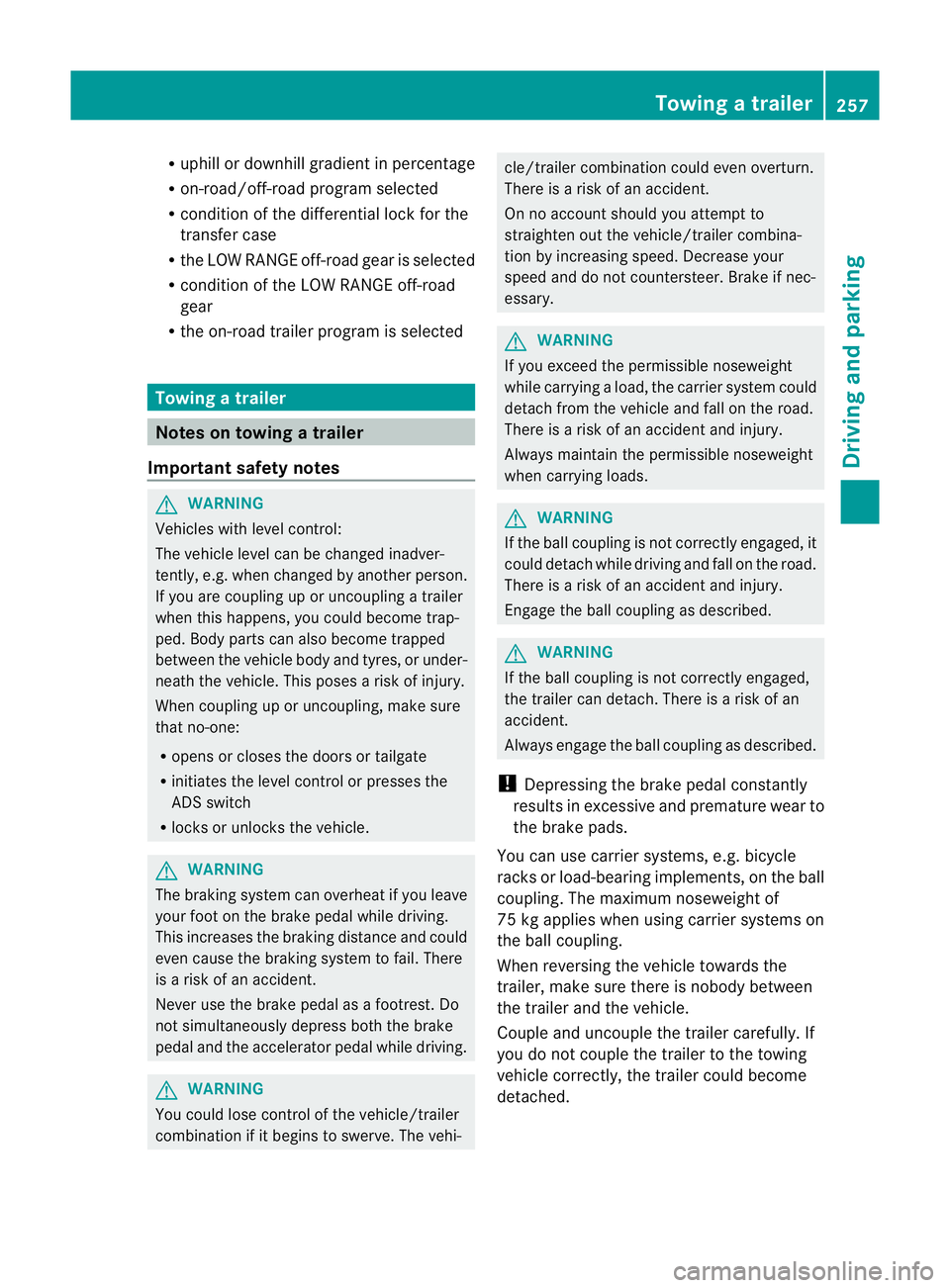
R
uphill or downhill gradien tinpercentage
R on-road/off-road program selected
R condition of the differential lock for the
transfer case
R the LOW RANGE off -road gear is selected
R condition of the LOW RANGE off -road
gear
R the on-roa dtrailer progra misselected Towing
atrailer Note
sont owingatrailer
Important safety notes G
WARNING
Veh icle sw ithl evel control:
Th ev ehicle level can be change dinadver-
tently, e.g. whe nchanged by anot her person.
If yo uare coupling up or uncoupling atrailer
when this happens ,you coul dbecom etrap-
ped. Bod yparts can also become trapped
between the vehicle body and tyres, or under-
neath the vehicle. This pose sarisk of injury.
When coupling up or uncoupling, make sure
that no-one:
R opens or closes the doors or tailgate
R initiates the level control or presses the
AD Ss witch
R locks or unlock sthe vehicle. G
WARNING
The brakin gsystem can overheat if you leave
your foot on the brake pedal while driving.
This increase sthe brakin gdistanc eand could
even cause the braking system to fail. There
is ar isk of an accident.
Never use the brake pedal as afootrest. Do
not simultaneously depress both the brake
pedal and the accelera torp edal while driving. G
WAR
NING
You could los econtrol of the vehicle/trailer
combination if it begins to swerve. The vehi- cle/
trailer combination could even overturn.
There is arisk of an accident.
On no account should you attempt to
straighten out the vehicle/trailer combina-
tion by increasing speed. Decrease your
speed and do not countersteer .Brake if nec-
essary. G
WARNING
If you excee dthe permissible noseweight
while carrying aload, the carrier system could
detac hfrom th evehicle and fall on the road.
There is arisk of an acciden tand injury.
Always maintain the permissible noseweight
whe ncarrying loads. G
WARNING
If the ball coupling is not correctly engaged ,it
coul ddetac hwhile drivin gand fall on the road.
There is arisk of an acciden tand injury.
Engag ethe ball coupling as described. G
WARNING
If the ball coupling is not cor rectly engaged,
the traile rcan detach. There is arisk of an
accident.
Always engage the ball coupling as described.
! Depressing the brake pedal constantly
results in excessive and premature wear to
the brake pads.
You can use carrier systems, e.g. bicycle
rack sorload-bearing implements, on the ball
coupling. The maximum noseweight of
75 kg applies when using carrier system son
the ball coupling.
Whe nreversin gthe vehicle towards the
trailer ,make sure there is nobody between
the trailer and the vehicle.
Couple and uncouple the trailer carefully. If
you do not couple the trailer to the towing
vehicle correctly, the trailer could become
detached. Towin
gatrailer
257Driving an dparking Z
Page 311 of 441
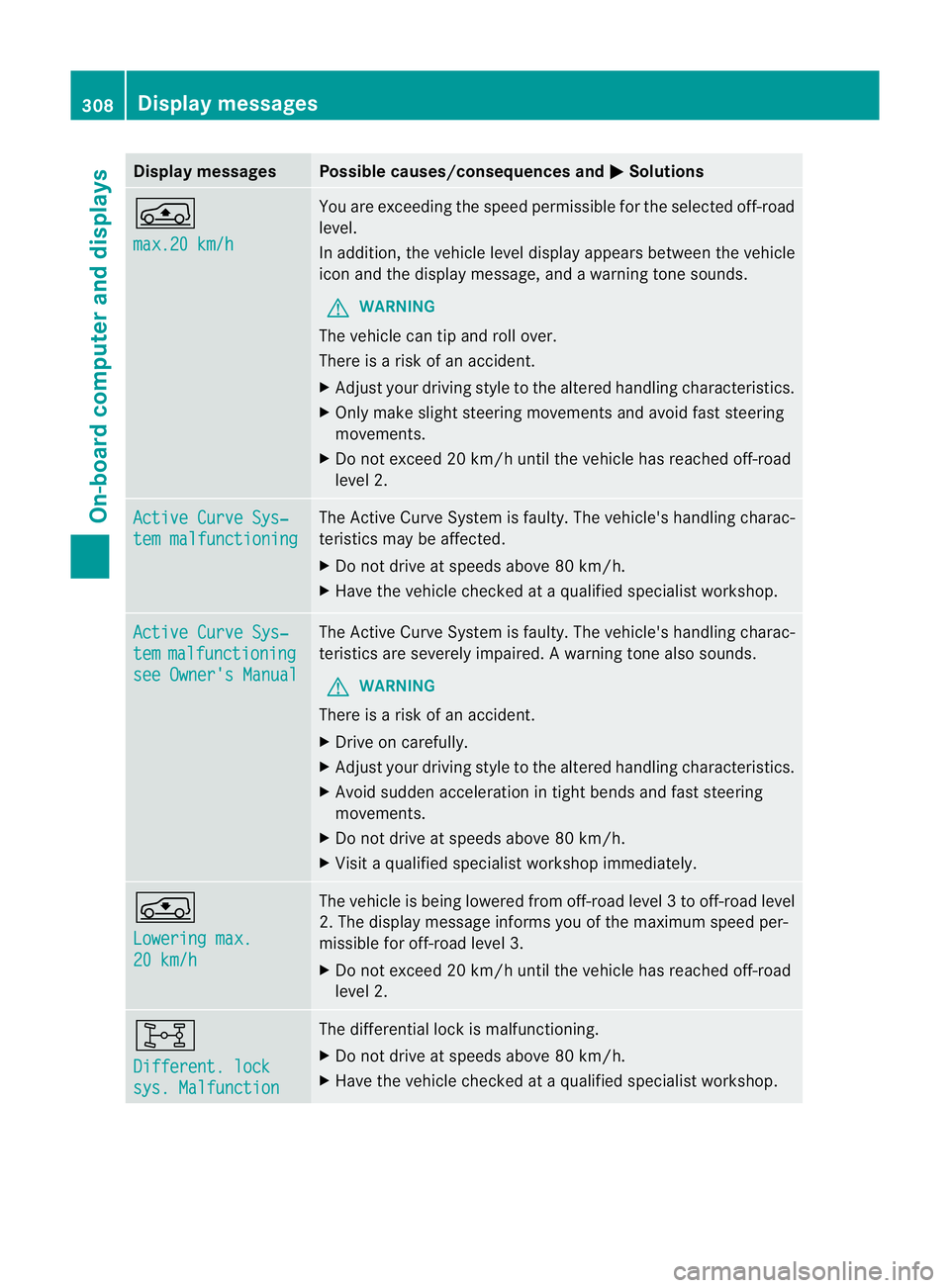
Displa
ymessages Possible causes/consequences and
M Solutions
Á
ma
x.20 km/h Yo
ua re exceedi ngthe speed permissible for the selected off-road
level.
In addition, the vehicle level display appears betwee nthe vehicle
icon and the display message, and awarning tone sounds.
G WARNING
The vehicle can tip and roll over.
There is arisk of an accident.
X Adjust your drivin gstyle to the altered handling characteristics.
X Only make slight steering movement sand avoid fast steering
movements.
X Do not excee d20km/h unti lthe vehicle has reached off-road
level 2. Active Curv
eSys‐ tem malfunctioning Th
eA ctive Curve Syste misfaulty. The vehicle's handling charac-
teristics may be affected.
X Do not drive at speeds above 80 km/h.
X Have the vehicle checked at aqualified specialist workshop. Active Curv
eSys‐ tem malfunctioning
see Owner's Manual Th
eA ctive Curve Syste misfaulty. The vehicle's handling charac-
teristics are severely impaired. Awarning ton ealso sounds.
G WARNING
Ther eisar isk of an ac cident.
X Drive on carefully.
X Adjust your driving styl etothe altered handling characteristics.
X Avoid sudde nacceleratio nintightbends and fast steering
movements.
X Do not driv eatspeeds above 80 km/h.
X Visit aqualified specialist workshop immediately. g
Loweri
ng max.
20 km/h Th
ev ehicle is being lowered from off -road leve l3tooff-road level
2. Th edisplay message informs you of the maximum speed per-
missible for off- road level 3.
X Do not exceed 20 km/ huntil the vehicl ehas reached off-road
level 2. 8
Different. lock
sys. Malfunction The differential lock is malfunc
tioning.
X Do not drive at speeds abov e80km/h.
X Have th evehicle checked at aqualified specialist workshop. 308
Display messagesOn-board computer and displays
Page 312 of 441
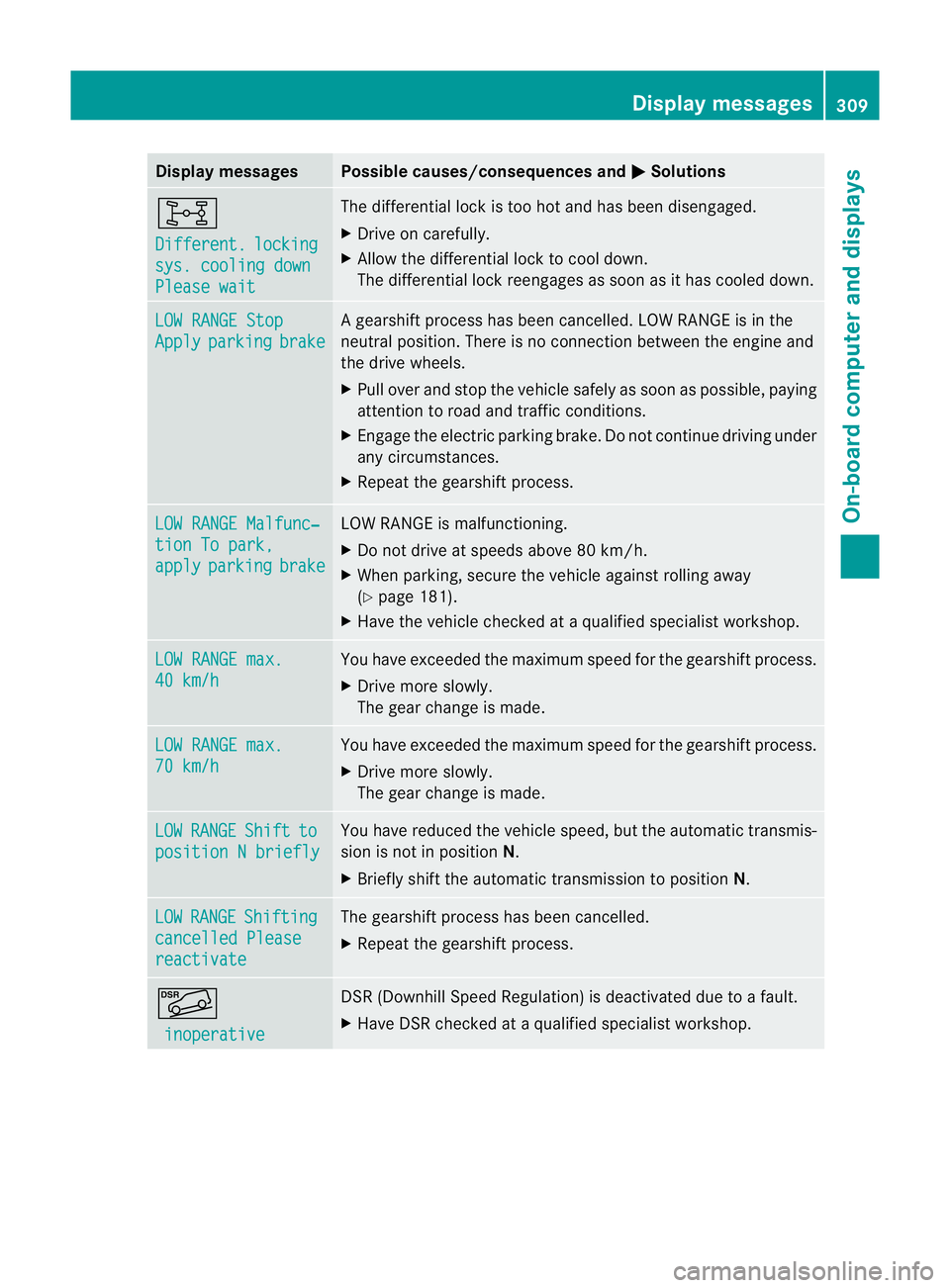
Displa
ymessages Possible causes/consequences and
M Solutions
8
Di
fferent. locking
sys
.c oolin gdown Please wait Th
ed ifferential loc kistoo hot and has been disengaged.
X Drive on carefully.
X Allow the differential lock to cool down.
The differential lock reengages as soon as it has cooled down. LO
WR ANGE Stop Apply parking brake Ag
earshif tprocess ha sbeen can celled. LOW RANGE is in the
neutral position. There is no connection between the engine and
the driv ewheels.
X Pull over and stop the vehicle safely as soon as possible, paying
attention to roa dand traffic conditions.
X Engag ethe electric parkin gbrake .Don ot con tinue driving under
any circumstances.
X Repe atthe gearshift process. LOW RANGE Malfunc‐
tion To park,
apply parking brake LO
WR ANGE is malfunctioning.
X Do not drive at speeds above 80 km/h.
X Whe nparking, secure the vehicle against rolling away
(Y page 181).
X Have the vehicle checked at aqualified specialist workshop. LO
WR ANGE max. 40 km/h Yo
uh ave exceeded the maximum spee dfor the gearshift process.
X Drive mor eslowly.
The gear change is made. LO
WR ANGE max. 70 km/h Yo
uh ave exceeded the maximum spee dfor the gearshift process.
X Drive mor eslowly.
The gear change is made. LOW RANGE Shift to
position
Nbriefly Yo
uh ave reduced the vehicle speed, but the automatic transmis-
sion is not in position N.
X Briefly shift the automatic transmission to position N.LOW RANGE Shifting
cancelle
dPlease reactivate Th
eg earshif tprocess ha sbeen cancelled.
X Repeat the gearshif tprocess. Ã
inoperative DSR (Downhil
lSpeed Regulation) is deactivated due to afault.
X Hav eDSRchecked at aqualified specialist workshop. Display messages
309On-boar dcomputer and displays Z
Page 392 of 441
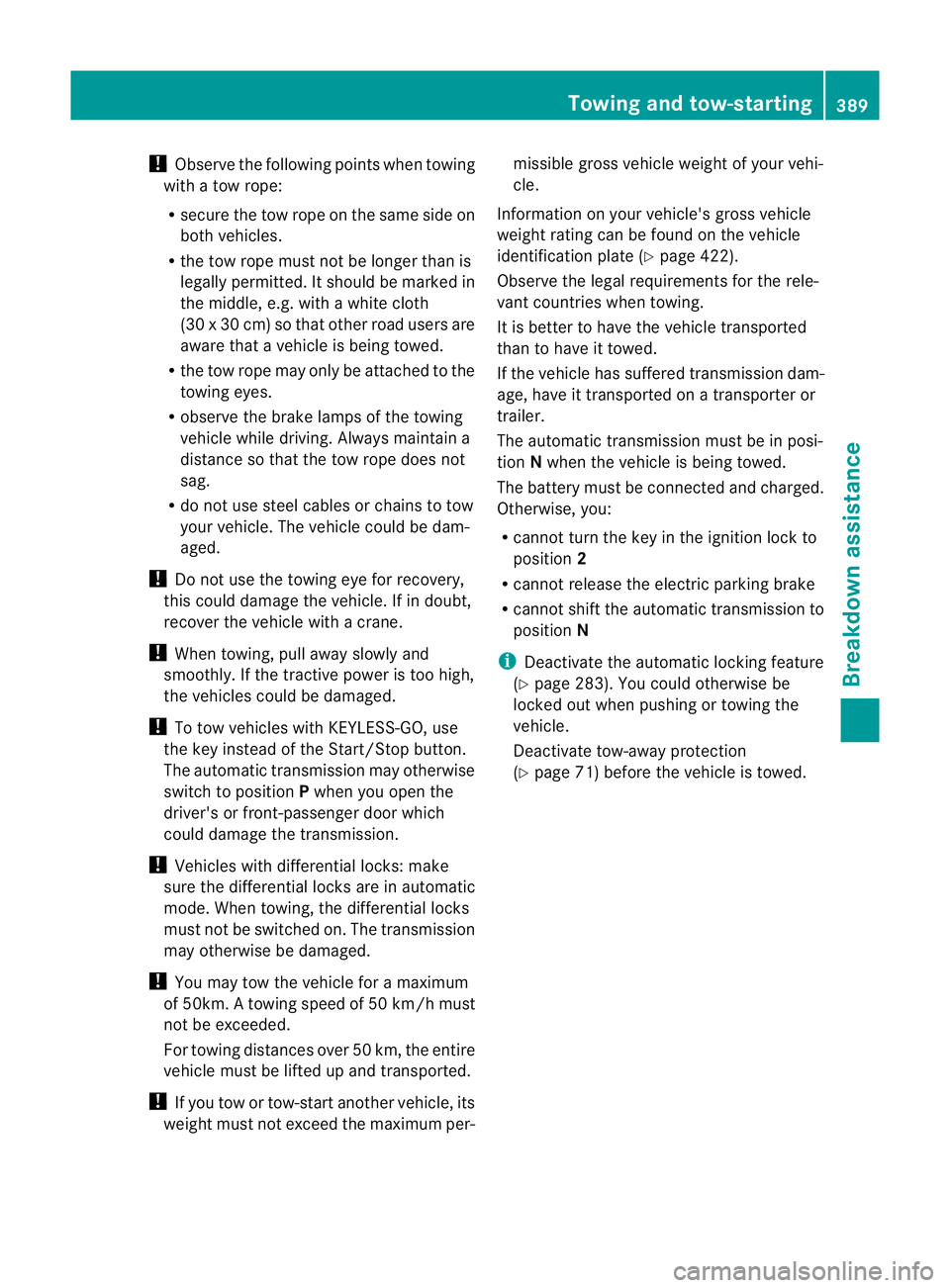
!
Observe the following points when towing
wit hat ow rope:
R secur ethe tow rope on the sam eside on
both vehicles.
R the tow rope must not be longer than is
legally permitted. It should be marked in
the middle, e.g. with awhite cloth
(30 x30c m) so that other roa dusers are
aware that avehicle is being towed.
R the tow rope may only be attached to the
towing eyes.
R observ ethe brake lamps of the towing
vehicle while driving. Always maintain a
distanc esothat the tow rope does not
sag.
R do not use steel cables or chains to tow
your vehicle. The vehicle could be dam-
aged.
! Do not use the towing eye for recovery,
this could damage the vehicle. If in doubt,
recover the vehicle with acrane.
! When towing, pu llaway slowly and
smoothly .Ifthe tractive power is too high,
the vehicles could be damaged.
! To tow vehicles with KEYL ESS-GO,use
the key instead of the Star t/Stop button.
Th ea utomatic transmission may otherwise
switch to position Pwhen you open the
driver' sorfront-passenger door which
could damag ethe transmission.
! Vehicles with differential locks: make
sur ethe differential lock sare in automatic
mode. When towing, th edifferential locks
must not be switched on. The transmission
may otherwise be damaged.
! You may tow the vehicle for amaximum
of 50km .Atowing speed of 50 km/h must
not be exceeded.
For towin gdistances over 50 km, the entire
vehicle must be lifted up and transported.
! If you tow or tow-start another vehicle, its
weight must not exceed the maximum per- missible gross vehicle weight of your vehi-
cle.
Information on your vehicle' sgros svehicle
weight rating can be foun donthe vehicle
identification plat e(Ypage 422).
Observe the legal requirement sfor the rele-
vant countries when towing.
It is bette rtoh ave the vehicle transported
than to have it towed.
If the vehicle has suffered transmission dam-
age, have it transported on atransporter or
trailer.
Th ea utomatic transmission must be in posi-
tion Nwhen the vehicle is being towed.
The battery must be connected and charged.
Otherwise, you:
R cannot turn the key in the ignition lock to
position 2
R cannot release the electric parking brake
R cannot shift the automatic transmission to
position N
i Deactivate the automatic locking feature
(Y page 283). You could otherwis ebe
locked out when pushing or towing the
vehicle.
Deactivate tow-away protection
(Y page 71) before the vehicle is towed. Towing and tow-starting
389Breakdown assistance Z